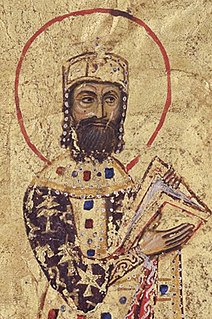Related Research Articles
The 1000s was a decade of the Julian Calendar which began on January 1, 1000, and ended on December 31, 1009.
The 1040s was a decade of the Julian Calendar which began on January 1, 1040, and ended on December 31, 1049.
The 1090s was a decade of the Julian Calendar which began on January 1, 1090, and ended on December 31, 1099.
The 1070s was a decade of the Julian Calendar which began on January 1, 1070, and ended on December 31, 1079.
The 1100s was a decade of the Julian Calendar which began on January 1, 1100, and ended on December 31, 1109.
The 980s decade ran from January 1, 980, to December 31, 989.
The 1050s was a decade of the Julian Calendar which began on January 1, 1050, and ended on December 31, 1059.

Year 1080 (MLXXX) was a leap year starting on Wednesday of the Julian calendar.

Year 1084 (MLXXXIV) was a leap year starting on Monday of the Julian calendar.

Year 1095 (MXCV) was a common year starting on Monday of the Julian calendar.
The 1120s was a decade of the Julian Calendar which began on January 1, 1120, and ended on December 31, 1129.
The 1110s was a decade of the Julian Calendar which began on January 1, 1110, and ended on December 31, 1119.
Year 1118 (MCXVIII) was a common year starting on Tuesday of the Julian calendar.

Year 1110 (MCX) was a common year starting on Saturday of the Julian calendar.
The 1010s was a decade of the Julian Calendar which began on January 1, 1010, and ended on December 31, 1019.
The 1030s was a decade of the Julian Calendar which began on January 1, 1030, and ended on December 31, 1039.

Year 1059 (MLIX) was a common year starting on Friday of the Julian calendar.

Year 1081 (MLXXXI) was a common year starting on Friday of the Julian calendar.

Year 1085 (MLXXXV) was a common year starting on Wednesday of the Julian calendar.
The 1020s was a decade of the Julian Calendar which began on January 1, 1020, and ended on December 31, 1029.
References
- ↑ Brian Todd Carey (2012). Road to Manzikert: Byzantine and Islamic Warfare (527–1071), p. 158. ISBN 978-1-84884-215-1.
- ↑ John France (1994). Victory in the East (Book extract). ISBN 9780521589871.
Godfrey was almost certainly present in support of Henry IV at the battle of Elster in 1080 (sic 1085... an error or typo), when the forces of the anti-king Rudolf triumphed on the field only to see their victory nullified because Rudolf was killed
. - ↑ Williams, Hywel (2005). Cassell's Chronology of World History. London: Weidenfeld & Nicolson, pp. 113–114. ISBN 0-304-35730-8.
- ↑ Picard C. (1997). La mer et les musulmans d'Occident au Moyen Age. Paris: Presses Universitaires de France.
- ↑ Herbert Edward John Cowdrey (1998). Pope Gregory VII, 1073–1085, pp. 201–202 (Oxford University Press).
- ↑ Brian Todd Carey (2012). Road to Manzikert: Byzantine and Islamic Warfare (527–1071), p. 158. ISBN 978-1-84884-215-1.
- ↑ Norwich, John Julius (1995). Byzantium: The Decline and Fall, p. 16. London, United Kingdom: Viking. ISBN 0-670-82377-5.
- ↑ The Welsh Academy. Encyclopaedia of Wales .
- ↑ Fine, John V. A. Jr. (1991) [1983]. The Early Medieval Balkans: A Critical Survey from the Sixth to the Late Twelfth Century. Ann Arbor, Michigan: University of Michigan Press. p. 282. ISBN 0-472-08149-7.
- ↑ Crowley, Roger (2012). City of Fortune: How Venice Ruled the Seas. New York: Random House. ISBN 978-1400068203.
- ↑ Yates, Nigel; Welsby, Paul A. (1996). Faith and Fabric: A History of Rochester Cathedral, 604-1994. Boydell & Brewer. p. 217. ISBN 9780851155814.
- ↑ Martínez Diez, Gonzalo (2007). El Cid histórico (in Spanish), p. 137. Barcelona: Editorial Planeta, S.A. ISBN 978-84-08-07165-5.
- ↑ Picard C. (1997). La mer et les musulmans d'Occident au Moyen Age. Paris: Presses Universitaires de France.
- ↑ "Henry IV, Holy Roman Emperor". Encyclopedia Britannica. Retrieved 8 August 2018.
- ↑ E, Harvey G. (2000). History of Burma. Asian Educational Services. p. 36. ISBN 9788120613652.
- ↑ "Carthusian religious order". Encyclopedia Britannica. Retrieved 8 August 2018.
- ↑ "Domesday Book". www.nationalarchives.gov.uk. Retrieved 25 April 2018.
- ↑ "British History in depth: The Domesday Book". BBC - History. Retrieved 25 April 2018.
- ↑ Dobson, R. B. (2000). Encyclopedia of the Middle Ages. New York: Routledge. p. 1349. ISBN 1-57958-282-6.
- ↑ W.G. Hoskins, "The Making of the English Landscape", Hodder & Stoughton 1955, also Pelican Books 1970.
- ↑ Gilbert Meynier (2010). L'Algérie cœur du Maghreb classique. De l'ouverture islamo-arabe au repli (658-1518). Paris: La Découverte; p. 83.
- ↑ Gilbert Meynier (2010). L'Algérie cœur du Maghreb classique. De l'ouverture islamo-arabe au repli (658-1518). Paris: La Découverte; p. 56.
- ↑ Kleinhenz, Christopher (2010). Medieval Italy: an encyclopedia. New York: Routledge. p. 95. ISBN 978-0-415-93930-0.
- ↑ Gilbert Meynier (2010). L'Algérie cœur du Maghreb classique. De l'ouverture islamo-arabe au repli (658–1518). Paris: La Découverte; p. 83.
- ↑ McGrank, Lawrence (1981). "Norman crusaders and the Catalan reconquest: Robert Burdet and te principality of Tarragona 1129–55". Journal of Medieval History. 7 (1): 67–82. doi:10.1016/0304-4181(81)90036-1.
- ↑ Canellas, Angel (1951). "Las Cruzadas de Aragon en el Siglo XI". Argensola: Revista de Ciencias Sociales del Instituto de Estudios Altoaragoneses. 7. ISSN 0518-4088. Archived from the original on July 14, 2014. Retrieved February 22, 2012.
- ↑ Pope Bl. Urban II, Catholic Encyclopedia, http://www.newadvent.org/cathen/15210a.htm
- ↑ Siecienski, Anthony Edward (2010). The Filioque: History of a Doctrinal Controversy. Oxford University Press. p. 117. ISBN 978-0-19-537204-5.